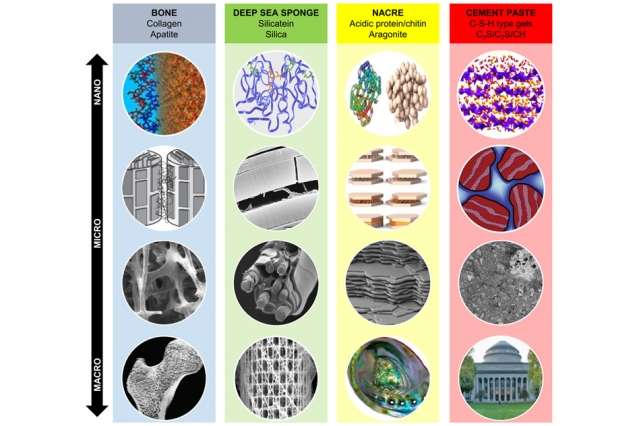Bones and shells could produce more durable concrete
Researchers at MIT are seeking to redesign concrete by following nature's blueprints. In a paper published online in the journal Construction and Building Materials, the team contrasts cement paste with the structure and properties of natural materials such as bones, shells, and deep-sea sponges. As the researchers observed, these biological materials are exceptionally strong and durable, thanks in part to their precise assembly of structures at multiple length scales, from the molecular to the macro, or visible, level.
From their observations, the team, led by Oral Buyukozturk, a professor in MIT's Department of Civil and Environmental Engineering (CEE), proposed a new bioinspired, "bottom-up" approach for designing cement paste.
Ultimately, the team hopes to identify materials in nature that may be used as sustainable and longer-lasting alternatives to Portland cement, which requires a huge amount of energy to manufacture.
"If we can replace cement, partially or totally, with some other materials that may be readily and amply available in nature, we can meet our objectives for sustainability," Buyukozturk says.
Co-authors on the paper include lead author and graduate student Steven Palkovic, graduate student Dieter Brommer, research scientist Kunal Kupwade-Patil, CEE assistant professor Admir Masic, and CEE department head Markus Buehler, the McAfee Professor of Engineering.
"The merger of theory, computation, new synthesis, and characterisation methods have enabled a paradigm shift that will likely change the way we produce this ubiquitous material, forever," Buehler says. "It could lead to more durable roads, bridges, structures, reduce the carbon and energy footprint, and even enable us to sequester carbon dioxide as the material is made. Implementing nanotechnology in concrete is one powerful example [of how] to scale up the power of nanoscience to solve grand engineering challenges."
Today's concrete is a random assemblage of crushed rocks and stones, bound together by a cement paste. Concrete's strength and durability depends partly on its internal structure and configuration of pores. For example, the more porous the material, the more vulnerable it is to cracking. However, there are no techniques available to precisely control concrete's internal structure and overall properties.
A comparison of natural materials and cement paste demonstrates the steps by which smaller pieces assemble to form larger structures. As Buyukozturk describes it, the "mesoscale" represents the connection between microscale structures and macroscale properties. For instance, how does cement's microscopic arrangement affect the overall strength and durability of a tall building or a long bridge?
Understanding this connection would help engineers identify features at various length scales that would improve concrete's overall performance. Therefore, Buyukozturk and colleagues looked to biological materials such as bone, deep sea sponges, and nacre (an inner shell layer of mollusks), which have all been studied extensively for their mechanical and microscopic properties.

They looked through the scientific literature for information on each biomaterial, and compared their structures and behavior, at the nano-, micro-, and macroscales, with that of cement paste.
They looked for connections between a material's structure and its mechanical properties. For instance, the researchers found that a deep sea sponge's onion-like structure of silica layers provides a mechanism for preventing cracks. Nacre has a "brick-and-mortar" arrangement of minerals that generates a strong bond between the mineral layers, making the material extremely tough.
Applying the information they learned from investigating biological materials, as well as knowledge they gathered on existing cement paste design tools, the team developed a general, bioinspired framework, or methodology, for engineers to design cement, "from the bottom up."
The framework is essentially a set of guidelines that engineers can follow, in order to determine how certain additives or ingredients of interest will impact cement's overall strength and durability.
For instance, in a related line of research, Buyukozturk is looking into volcanic ash as a cement additive or substitute. To see whether volcanic ash would improve cement paste's properties, engineers, following the group's framework, would first use existing experimental techniques, such as nuclear magnetic resonance, scanning electron microscopy, and X-ray diffraction to characterise volcanic ash's solid and pore configurations over time.
Researchers could then plug these measurements into models that simulate concrete's long-term evolution, to identify mesoscale relationships between, say, the properties of volcanic ash and the material's contribution to the strength and durability of an ash-containing concrete bridge.
These simulations can then be validated with conventional compression and nanoindentation experiments, to test actual samples of volcanic ash-based concrete.
Ultimately, the researchers hope the framework will help engineers identify ingredients that are structured and evolve in a way, similar to biomaterials, that may improve concrete's performance and longevity.










